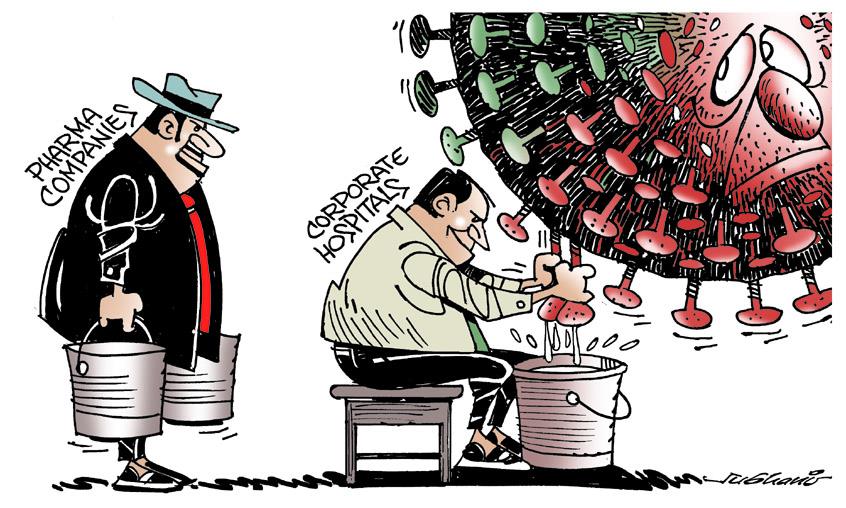The COVID-19 crisis is hitting India hard. Despite only spending 1.2 percent of GDP on healthcare, Modi is assuring his fellow countrymen that they do not need to worry; that India is equipped with the required infrastructure to cope with the pandemic. This is a blatant lie. The Indian healthcare system was devastated even before COVID-19, and it is certainly no better under the current crisis. With the coronavirus hitting all major towns and villages, the rottenness of the Indian healthcare system is laid bare. Here, we will analyse the situation facing the health system in India, the state’s inability to address the pandemic, the role of the private sector, the limits of Indian 'democracy' and the revolutionary road forward.
Based on officially submitted figures, India ranks 154 among 195 Countries in the Global Healthcare Index in terms of access and quality measures. Counting unofficial figures, it would rank even lower. Official government figures show India's doctor-to-population ratio is 1:1,655. For reference, the WHO recommends 1:1,000. In the government sector, there is one medical doctor per 11,000 people on average. In poor states such as Bihar, this number is 28,391, while in the capital city Delhi, the ratio is one doctor to every 2,203 people. The bed-to-population ratio is 0.5 per 1,000 on average, against the WHO recommendation of 3.5 per 1,000. The situation in rural areas is much grimmer. About 60 percent of the Indian healthcare system is in the hands of private profiteers who are benefitting from people’s illnesses.
Disease prevention for poor: a myth
India is not only a country that houses a quarter of the world's poor but also contains the highest numbers of people with chronic hunger: one of the significant factors contributing to disease vulnerability. Prevention of diseases is impossible in India. The Food and Agricultural Organisation estimates that 195 million people in India are undernourished, which is around 14.5 percent of the population. This is the official figure, but the reality is much worse. 70 percent of minor deaths are linked to hunger. More than 50 percent of the population lack access to clean drinking water. Pollution, traditionally considered an urban issue, is now ravaging villages and households in small towns, comprising 68 percent of the total population. While vehicles and uncontrolled industrial emissions are destroying the urban atmosphere, poisonous pesticide spray is doing the same to villages.
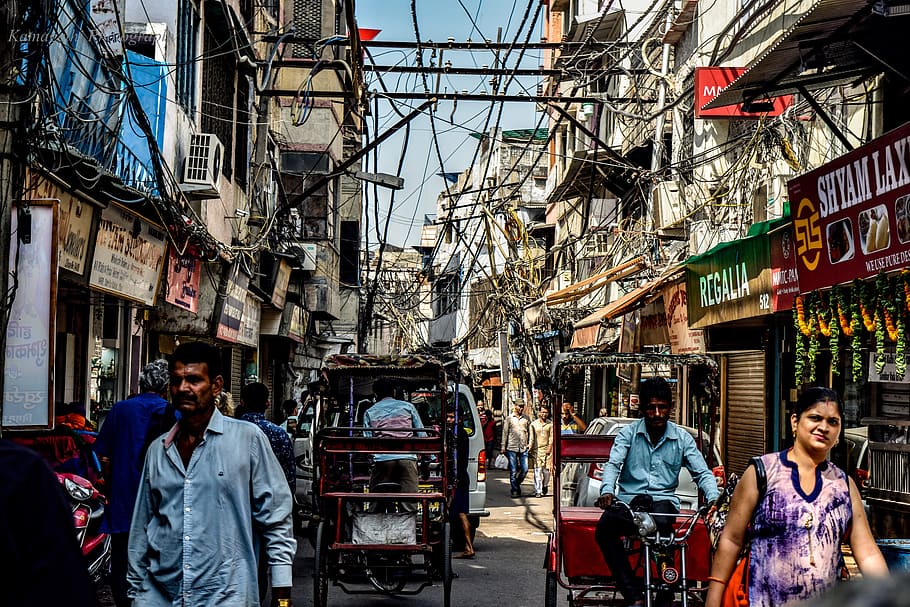 Pollution, profiteering, medical quackery and tainted food conspire to ruin millions of people's health / Image: pxfuel
Pollution, profiteering, medical quackery and tainted food conspire to ruin millions of people's health / Image: pxfuel
If the poor somehow manage to escape hunger, they still are vulnerable to diseases, given the condition of their food. In order to reduce costs and increase profits, dangerous chemicals and additives are introduced to food ingredients and sold to ordinary people by fatcats. This includes adulterations to spices, poisonous pesticide-ridden vegetables, chemically enhanced meat and milk, and oils dangerously high in saturated fats, in addition to a lack of hygiene in street foods. The Centre for Science and Environment Delhi estimates that 2 million deaths every year are caused worldwide by diarrhoea arising from contaminated food and water, 1.5 million of them children, and 700,000 of these in South Asia alone.
Access to quality public healthcare is a class issue in India, with the affluent having access to a clean environment, inside and outside their houses, while poor working-class people are forced to live in densely crowded and often polluted urban areas. The rich can afford to buy organic and pesticide-free, uncontaminated food, while the poor cannot even think of such luxuries. All state laws, regulations and control against food contamination only to help the rich. The poor are forced to eat unregulated and cheaply available, dangerous foods that test the limits of their immune systems.
Rural farmers and their families are exposed to dangerous pesticides on a daily basis. Poisonous sprays and byproducts from factories heavily contaminate rivers from which people obtain water for their daily use. Cancer is rife in rural Punjab and Haryana, considered breadwinner states, caused by poisonous pesticide sprays on farming lands. The irony is that there is no proper cancer treatment hospital in Punjab. The state runs a regular train known as the 'cancer train' through major farming villages across the states, collecting cancer patients and driving them hundreds of miles down to treatment centres in Bikaner Rajasthan.
The Indian government is fully aware of the public health crises, but turns a blind eye, because it is unable and unwilling to do anything under the present capitalist system of private profit production. Sick people are left at the mercy of the rotten healthcare system.
Wrecked government-run hospitals
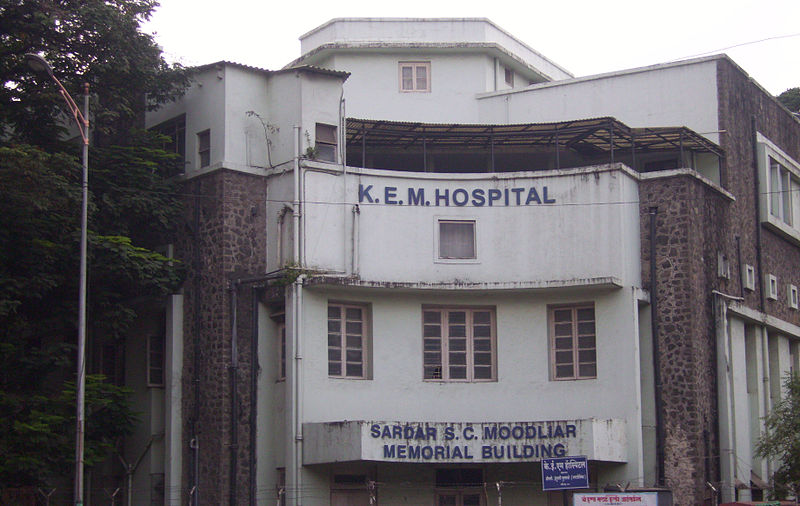
The situation in government hospitals is worse than one could ever imagine. Treatment is free, but people are treated like animals. The buildings of almost all state-run hospitals are crumbling due to corruption in the maintenance funds. Hardly any medical equipment is maintained properly.
In 2017, in Gorakhpur Uttar Pradesh, about 63 children were suffocated to death in front of their helpless parents, because the hospital ran out of liquid oxygen cylinders and the private contractor refused to supply oxygen because of a previous unpaid bill of $107,000. This incident provoked a nationwide protest.
The poor regions in India seldom have any proper functioning healthcare infrastructure. These regions are often infested with deadly disease outbreaks, with children most at risk. 80 percent of Primary Health Centres lack a qualified doctor, if they somehow exist in villages. Patients and their carers have to travel tens to hundreds of miles to reach a hospital with a qualified doctor. This gives rise to chronic overcrowding in state hospitals, which cannot refuse to take in new patients by law.
The leeching private hospitals
Private profiteering hospitals and treatment centres fill capacity gaps in the state healthcare system. But they are no better than their state-managed counterparts. In fact, they are much worse. Apart from a few large private hospitals, the majority are located in residential houses and makeshift office spaces. Only 10 percent of the 1 million doctors in India work in the public health sector, the rest are in the private sector. After spending tens of millions of rupees on medical college fees and other living expenses to become a doctor, the potentially lucrative private sector seems an attractive prospect for newly qualified medics, where they can earn high salaries and commissions from pharmaceutical companies. But still, doctors are in limited supply in most of the private hospitals as well. This does not stop private hospitals from regular functioning and performing complicated operations in the absence of doctors. If treatment goes wrong and the patient is near death, they are shifted to a state hospital to avoid liability and a bad reputation.
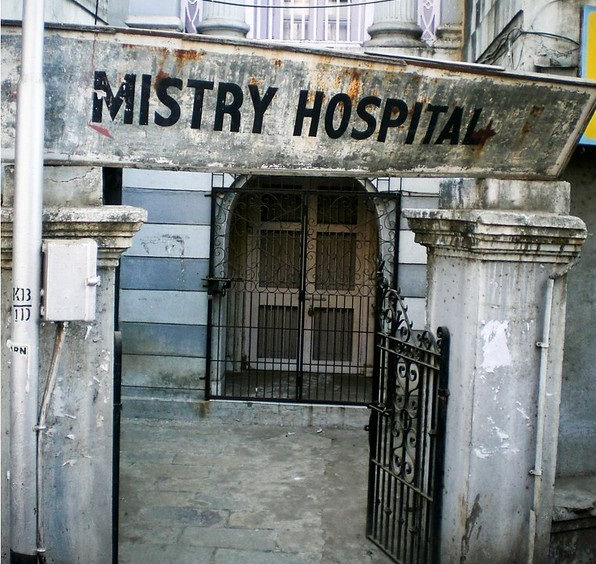 Hospitalisations can leave patients severely in debt / Image: alkautsar, Flickr
Hospitalisations can leave patients severely in debt / Image: alkautsar, Flickr
Bloodthirsty private hospital bosses pursue aggressive marketing tactics. They force their part-time doctors and nurses, who also work in state hospitals, to divert patients from the state hospitals to their private hospitals. Swindlers, con artists and cheats are hired on commission by these private hospitals for this purpose as well. Also, there is a whole fleet of private-run ambulances at the disposal of the swindlers, parked outside of state hospitals, ready to pick up incoming patients and their families, and redirect them to private hospitals.
In a private hospital, a patient gets everything – except proper treatment – at a high cost. Minor illnesses are diagnosed as major ones, and the patient ends up spending days in an expensive ward with daily mounting bills. If patients exhaust their supply of money in the middle of their treatments, they are kicked out of the hospital and/or immediately shifted to a state hospital. Hardly any poor people come out of hospital without colossal debts. Several private hospitals also employ the services of thugs for debt recovery from patients and their families. In a lot of cases, local police officers extend their services as debt collectors on behalf of the private hospitals for a commission.
Private hospitals in rural areas are hotbeds for the illegal human organ trade. The government has formed teams to do surprise checks in PHCs and hospitals for quality control, but due to rampant corruption and political connections, nothing happens to improve private hospitals’ conduct.
Several NGOs and philanthropists are active in healthcare and often provide free or low-cost treatment facilities to the poor. Large Indian capitalists such as Nadar, Ambani, Piramal, Premji, Godrej, Adani and others have opened charity hospitals. But only a tiny percentage of patients are treated free of cost; for the rest of the patients at these facilities, it is a rip-off. Often, charity is used as a vehicle to evade taxes by these big capitalists. Several international charities are linked to pharmaceutical multinationals, who use them as a means to penetrate into Indian markets or for drug trials.
The malpractice committed by private hospitals in their lust for profits has dire implications given the current pandemic. The New Meerut Hospital, a private facility in Uttar Pradesh, recently had its license revoked by the local government after a video came to light of an employee telling the relative of a patient that, for Rs 2,500, the hospital will provide a negative COVID-19 test report, so the patient will be able to go back to work and avoid quarantine. It transpired that the hosptial manager was behind this scheme. There have been 27,000 cases of COVID-19 and 785 deaths in Uttar Pradesh so far. Private sector crooks are willing to exploit the desperation of sufferering people, and push these numbers even higher in exchange for a quick profit.
Fake medicines and quackery
The pharmaceutical industry in India is appalling. International agencies suggest that 20 percent of medicines sold in India are fake, and a lot more are substandard – but the real figure is much higher. The inability of the government to regulate the pharmaceutical sector is encouraging all types of profiteering mafiosi to venture in the medicine manufacturing business. The poor can only access cheap, adulterated medicines with limited effects. Patients are supposed to get free medicines during their treatment in a state hospital, but due to rampant corruption, there is hardly any stock of free medicines. Patients have to visit pharmacies, which mushroom around hospitals, selling substandard medicines at high prices. Often patients and their families decide to abandon hospital treatment and let the patient suffer or die because they cannot afford the expense. Despite India's considerable exports of medicines to the USA and UK (80 percent of Britain's NHS generic medicines are imported from India), Indians at home are deprived of essential and lifesaving medicines.
The majority of Indians are going to quacks for cheap and unscientific treatments, the market for which is thriving. These snake oil salesmen often use a combination of various herbs with alleged ‘magical’ properties to treat real illness. Their 'treatments' are not only ineffective but often aggravate the illnesses of their patients, who then end up in hospital. The ruling class knows that they cannot provide effective healthcare to the population under capitalism; therefore, they are at the forefront of promoting such an unscientific approach to treatment, and keeping masses ignorant and reliant on 'magic'.
Various kinds of fake medicines are promoted in print and electronic media, including social media. Quacks who make fortunes for themselves also financially support politicians from the ruling parties. Prime Minister Modi himself is a staunch supporter of these ‘magic’ treatments, and regularly promotes fake medicines and regimes to cure serious illness, resulting in more deaths.
A famous multimillionaire quack named Baba Ram Dev is promoting such fake medicinal products in combination with yoga, and has even declared existing products called Coronil and Swasari as medicines to cure COVID-19.
One of the major panaceas churned out by BJP leaders is cow urine, which, according to them, can be used to treat all kinds of diseases, including COVID-19. This unscientific approach also permeates through the medical fraternity and many of them also firmly believe in such miracles, resulting in fatal methods of treatment for the poor patients. Religious leaders from Muslim, Buddhist and other communities also promote similar quackery which only adds to the general level of ignorance, in turn exacerbating unhygienic living and the spread of disease.
Hopeless healthcare for Indian women
The lives of women are much worse as they have to endure all of this ignorance and deprivation, in addition to the oppression that comes with being a woman. A large number of women die during childbirth due to unscientific methods of care during delivery. Women’s health is the lowest priority in typical, poor Indian households. The general atmosphere of prejudice and oppression towards women in society forces women to hide their illnesses due to shame, and many even prefer to die rather than disclose their medical problems. The lack of female doctors across the country also worsens their plight as many families will not allow any male doctor to touch their female relatives due to “family honour”.
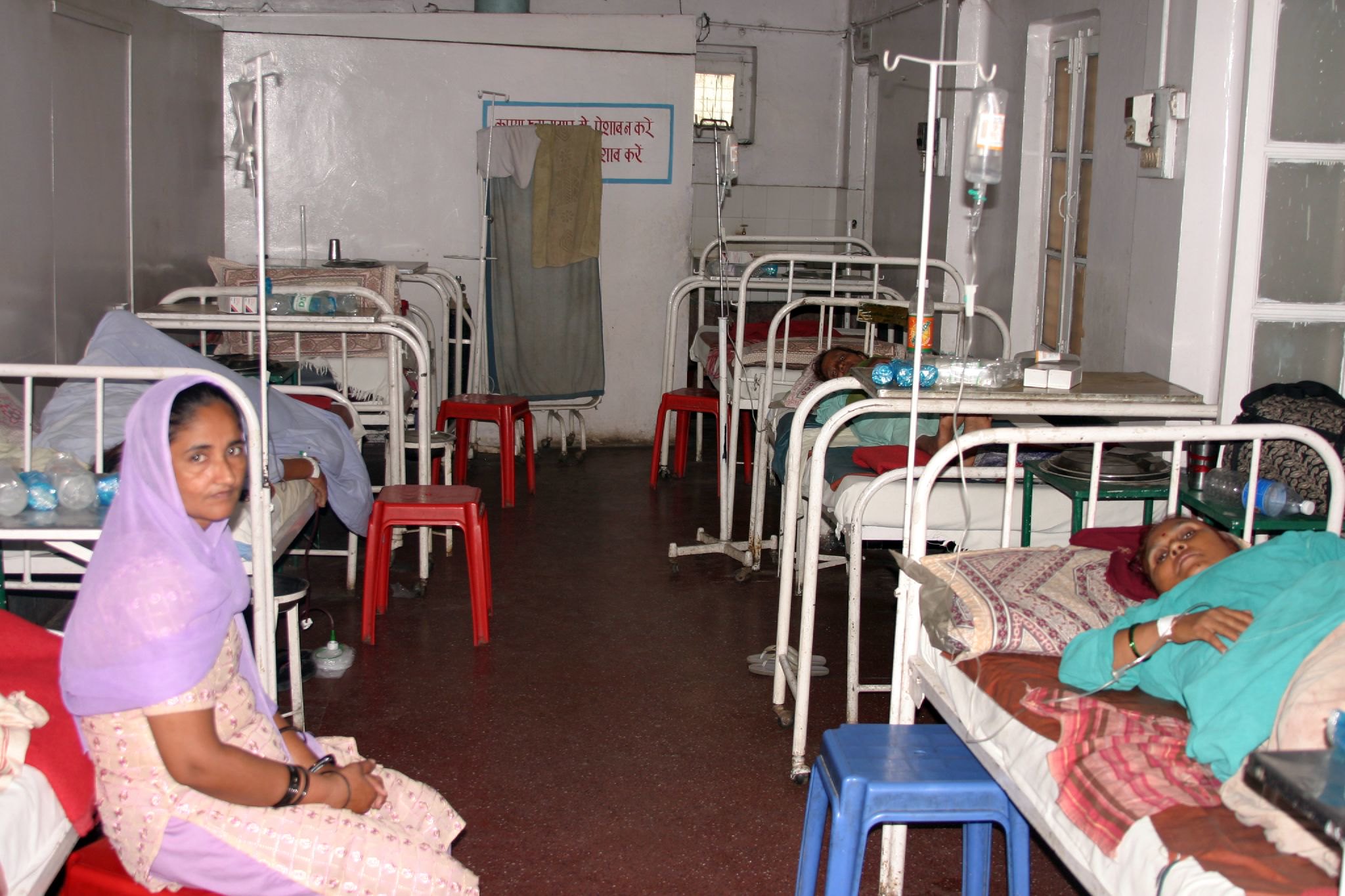 The public health situation for women in India is compounded by severe oppression / Image: ReSurge International, Flickr
The public health situation for women in India is compounded by severe oppression / Image: ReSurge International, Flickr
The development of technology under capitalism has only served to worsen the oppression of women rather than overcome it. The ultrasound machine, which should help the women in pregnancy identify problems with the baby or themselves, has become an instrument for more barbaric oppression towards women. Every year in India, hundreds of thousands of sex-selective abortions are carried out. Female foetuses that are detected early through ultrasound technology are forcefully aborted. The practice has reached such horrific levels that, in some states, like Haryana, the disproportion in population ratio between males and females have reached levels never seen in history. The birth of a female, still seen as stigma and dishonour, results in a lack of interest in their healthcare and wellbeing. This results in a life filled with sickness and disease for most of the women living in poverty.
The option of surrogacy has also become twisted under class society. This technology should be a boon for women who have medical issues and can't bear children, but under capitalism, it is being used by rich women to avoid the pain of childbirth, by hiring poor women to endure the suffering for a meagre sum of money, and then handing over the child to its 'mother'.
A sick and disgusting concept still prevails in India, where menstrual periods are considered impure and therefore, women are not allowed in temples or mosques. In a country where 90-100 women are raped each day – often by strangers – if the lives of these women are spared by their relatives, who accuse them of dishonouring their families, they suffer psychological and mental trauma for the whole of their lives, which goes untreated.
The lack of toilets across India has been an issue discussed frequently in politics, and open defecation is a routine for millions of people across the country. But for women, this is a particular nightmare, as they have to wait for midnight or other odd hours to relieve themselves. Many face sexual assaults even during this process. In this situation, safe and hygienic living has become a luxury for a significant majority of the population. Modi launched a campaign named 'Swachh Bharat Mission' in 2014 to build 90 million toilets in cities and towns, with a budget of $8.7 billion. Since its inception, the project has been riddled with massive corruption, wasteful spending and did not manage to address the sanitation issue at all, as fields and rivers are still being polluted as a result of this project. Rural people are being forced to use these toilets, threatening their electricity connections and public food subsidy entitlements, again disproportionately affecting women.
Given all these circumstances, the Indian healthcare system cannot cope with the COVID-19 crisis. There are insufficient doctors, non-existent care centres, scant hospital beds, a lack of medical equipment such as ventilators and PPE, and preventive medicines are often out of reach of the majority. Given the already chronic overcrowding of state hospitals, the situation is accelerating towards a total collapse, with rising COVID-19 cases. There are reports of two and even three patients sharing a single hospital bed. There isn't enough oxygen available in hospitals. Ventilators and oxygen masks are only given to preferred patients, while the rest are left to suffocate and die. The official figures at the start of July 2020 state that 200,000 COVID-19 patients are under treatment, with 16,000 deaths. However, given the condition of hospitals and lack of data collection, the actual figure is likely much higher. Private hospitals, pharmacies and quacks are making a killing off the crisis out of COVID-19 tests and fake treatments. And even if the life of a poor working-class person is saved through COVID-19 treatments, they will be saddled with crippling debt.
Political parties: pouring old wines in a new bottle
The political parties are totally inept at addressing the crisis faced by the Indian healthcare system. The Congress Party continuously put free health in its election manifestos, such as in 2014 and 2019, however, they didn't manage to get significant traction on this. This is because, during the Congress-led governments, massive cuts to healthcare were made and privatisation was encouraged in the sector. For example, Congress promised free healthcare for all in 2009, but after assuming office, it did nothing to fulfil that promise but instead brought the concept of health insurance for low-income families under the name of Rashtriya Swasthya Bima Yojna (RSBY). It's akin to bringing the American healthcare model and bolting it on to a wrecked Indian healthcare system. This measure only benefited the private insurance industries and providers.
The BJP promised 'health assurance for all' in its 2014 manifesto. But on assuming power, it revamped RSBY with some cosmetic changes, such as the Ayushman Bharat (PMJAY), just before the election season of 2019, which is now being sold to the people as universal healthcare. These schemes, far from providing free and quality healthcare, are just a vehicle to shower masses of public funds on private healthcare profiteers and leeching insurance companies, without any improvements being made.
The bankruptcy of the communist parties
The disgusting condition of the communist parties is extremely visible when it comes to healthcare. On the one hand, they oppose the private healthcare system in words; but in reality are seen promoting large corporate-owned hospitals. They aren't calling for a complete nationalisation but talking about extending the same health insurance scheme. Furthermore, they are habitually aligned with right-wing parties, including Congress, and in doing so are continuously compromising and watering down their manifesto and promises. Despite having control of West Bengal and having complete autonomy on healthcare implementation for many decades, the communist parties led a massive privatisation programme, starting from public-private partnerships in healthcare at the behest of the World Bank and DFID. Such betrayals by the Stalinists not only cost them the West Bengal state government but also resulted in a complete wipe-out from the Indian political landscape. People see them as no different from other right-wing parties who are following similar privatisation and anti-worker programmes.
The revolutionary way forward
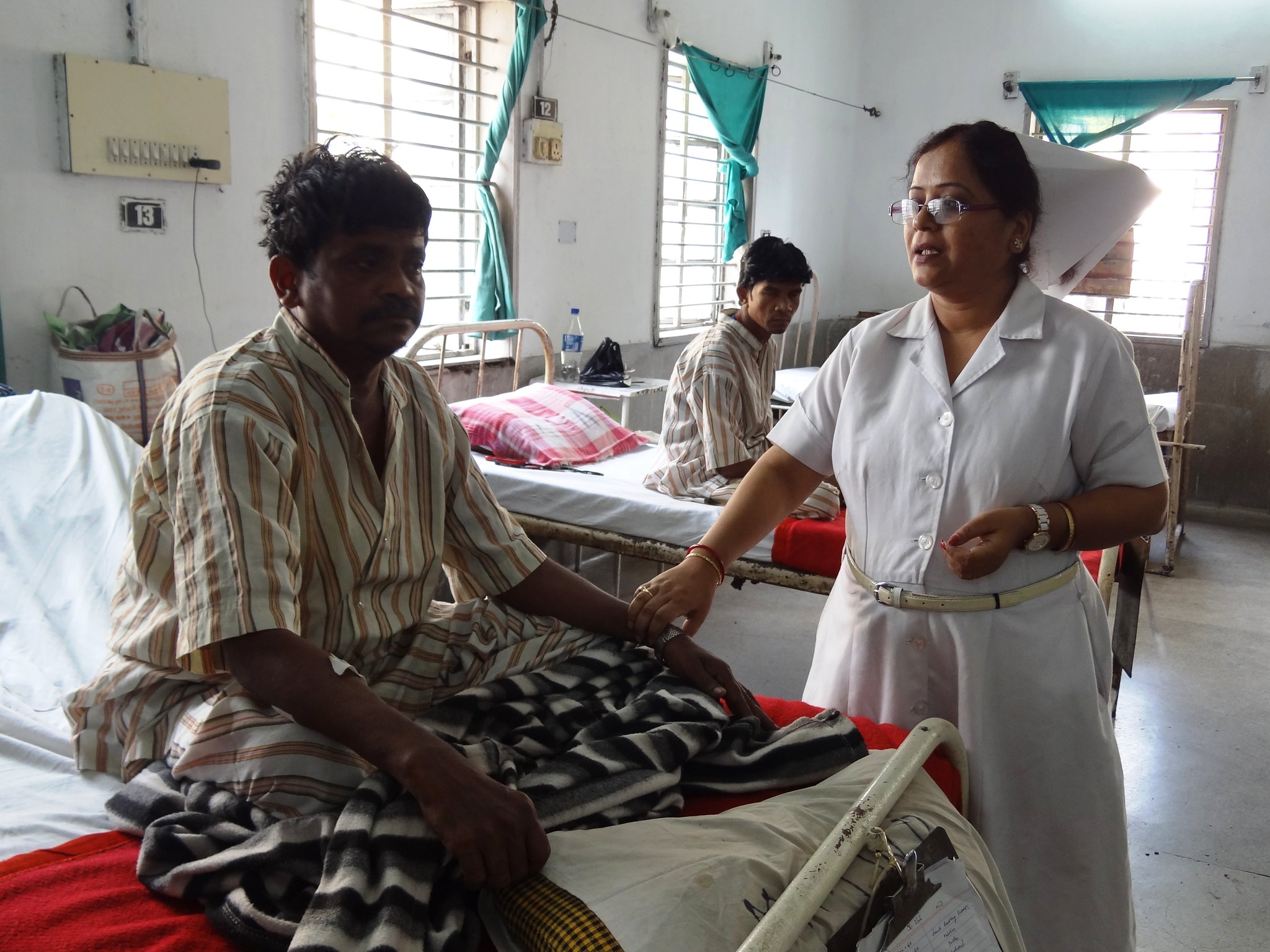 The Indian working-class deserves free healthcare, which this rotten capitalist system is incapable of providing / Image: ILO Asia Pacific, Flickr
The Indian working-class deserves free healthcare, which this rotten capitalist system is incapable of providing / Image: ILO Asia Pacific, Flickr
The Indian working-class deserves free healthcare. There are enough resources in the country to fund free healthcare for all. No charity, philanthropy or misplaced faith in right-wing political parties will resolve India’s healthcare crisis. Also, international development organisations and banks are only interested in profits and worker exploitation. One cannot expect the Indian healthcare system to run better under the present decaying capitalist system. Only the complete overthrow of capitalism will enable free healthcare in India. This is not possible through the currently rotten parliamentary politics or adopting the road of Stalinism, but through building a revolutionary organisation in India on Bolshevik lines.
It is the task of Indian youth and workers to overthrow this decaying capitalist system, which cannot be reformed and has not the slightest capacity to improve the lives of masses. Rather, in its death throes, it will murder millions more. The only way forward is to build a genuine Marxist tendency in India that can connect with the ongoing struggles of the workers and students on the basis of correct ideas for the revolutionary overthrow of capitalism, through the mass action of Indian working class. In the recent period, we have seen historic general strikes in India, which were able to paralyse the whole country. But what we saw also were shameless betrayals of the leaders who cashed on the anger of millions of working-class people to further their careers. The mainstream political parties, including so-called communist parties, criminally defuse the anger of masses with petty reforms and limited demands.
In the coming period, events on a much larger scale will be seen, bringing class struggle to the top of the political agenda, challenging the rule of government and big business who are making fortunes off the suffering and illness of the working-class. Only by overthrowing the bourgeois state and replacing it with a workers’ state, that could nationalise the commanding heights of the economy under the democratic control of workers, will we be able to provide free and scientifically sound healthcare to all people of India. Nothing less than this strategy can solve this burning issue of healthcare. Socialist revolution in India will be only the beginning of a process towards a socialist federation of South Asia and the world.

